The Type 1939 torpedo boat or Flottentorpedoboot 1939 (also known by the German designation Elbing-class torpedo boat) was a class of torpedo boats built by Nazi Germany’s Kriegsmarine during World War II. Despite the “torpedo boat” label, these vessels were closer for size and capability to destroyers. Indeed, unlike previous Type 35/37 they had a true destroyer-like armament of four 105 mm SK C/32 naval guns completed by a good AA made of 37 mm and 20 mm AA guns, still six 533 mm torpedo tubes and the capacity to lay up to 60 naval mines and ASW capable. Reaching almost 1800 tonnes fully loaded they were larger, more powerful and with a better range, reflecting their roles of Escort duties, Minelaying, ASW patrol and fleet support. Around 15 ships were built between 1941 and 1944 and they really made the bulk of operations as the stock of destroyers, already cut down after the 1940 Norwegian campaign, was not replenished. But they paid a heavy price with ten sunk, one which ran aground and 4 survivors, ending as war prizes.
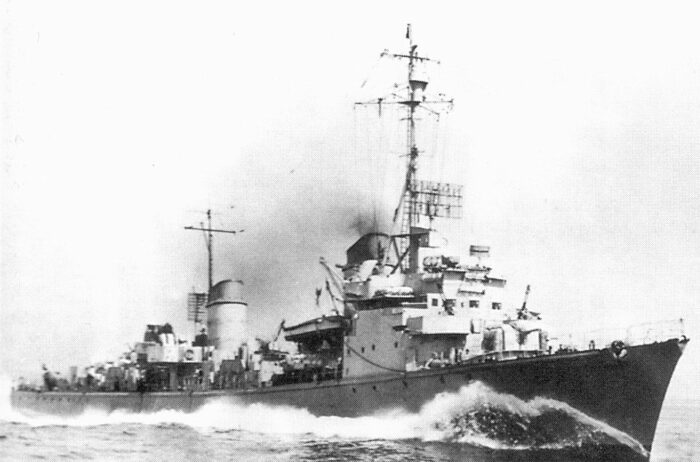
Development of the Flottentorpedoboot 1939
According to the provisions of the Treaty of Versailles, Germany had the right to replace 12 destroyers and 12 torpedo boats in service with the Reichsmarine, all antiquated pre-WWI units. The 12 destroyers were replaced by built the Raubtier and Raubvogel classes (or Type 23 and 24 destroyers) in the 1920s. Ten years later, there were the modern Torpedoboot 1935 classes, T1 to T12, and the improved Torpedoboot 1937 classes, T13 to T21. They had a standard displacement intended to fall below the 600-ton limit standard, exempting them from agreements in force at the time. The Washingon and London treaties that applied after the Germano-British agreements of 1935.
Großadmiral Erich Raeder however had a double problem. On one hand, he was unhappy with this 600 tons design, since as other countries discovered, it could be more sensibly built over 800 tons and performed better in high seas and in particular in heavy weather, being hopeless if of lower tonnage. Italy and Japan already showed it was possible to cheat on treaty limits for TBs. But even at this tonnage, this did not produce a viable type in his eyes. Ideally he wanted a new TB that will completely ignore treaty limits, at 1,200 tons standard, with a setup operational displacement of 1,700 tons. This clearly was in destroyer territory. 1500t was indeed the accepted standard for a fully fledged treaty destroyer but at this point this did not matter.
On the other hand, raeder was equally unhappy with the proposed Type 1938B-class destroyer voted by early 1939. He estimated them too costly and feared not enough would be built before a war broke out. Instead he wanted a cheaper alternative, for a ship that can be built as a fractionof te price, faster and in much larger quantities to fill the same role. He ordered a smaller vessel that was essentially a high seas 1,265-metric-ton (1,245-long-ton) torpedo boats that was 95-meter-long (311 ft 8 in) and capable of folling more roles than the previous Type 1935 and Type 1939. This next design was evaluated on 8 July 1939. But as the war broke out as feared in September, the Kriegsmarine re-evaluated its entire shipbuilding program. The Type 1938Bs were cancelled outright and all priority was given to the simpler and trusted Type 1936A-class design, as well as the smaller Type 39 torpedo boat, as complement.
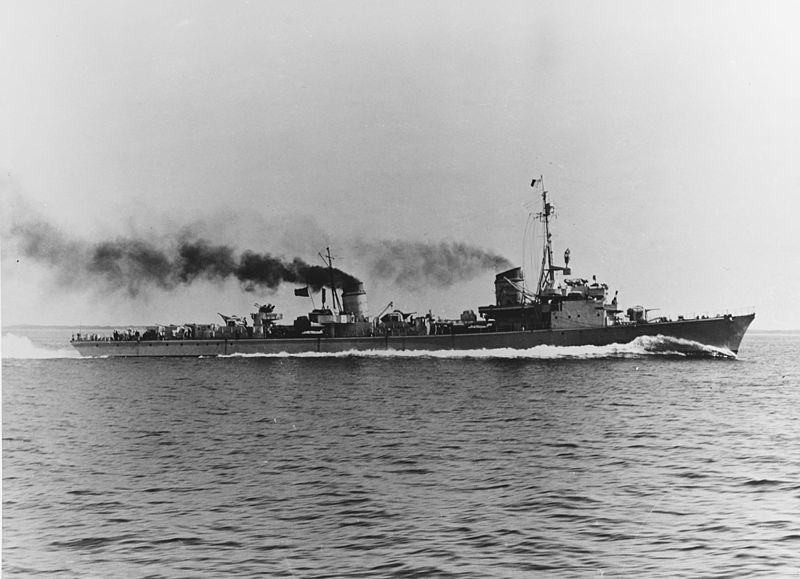
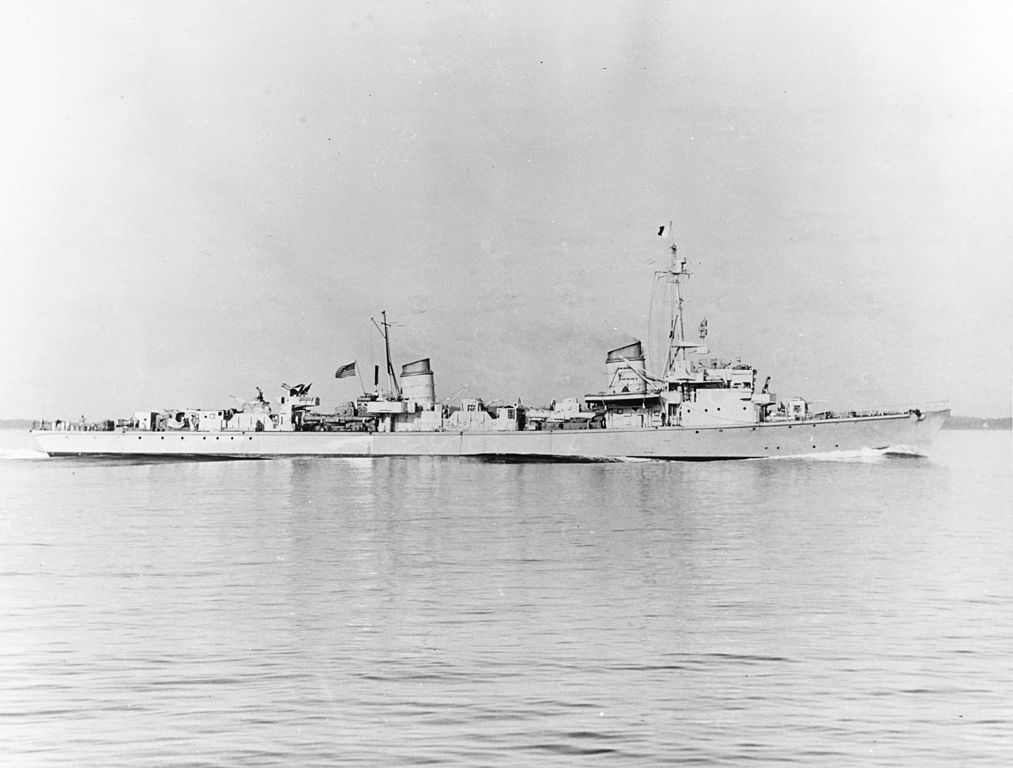
T-35 on sea trials in US waters. Note: They are the only creative commons photos of the type.
The Flottentorpedoboot 1939 was a radical change in design compared to the much smaller and limited torpedo boats of the Type 35 and Type 37 classes. The latter were indeed were seen as too specialized for torpedo attack. Artillery was reduced to a single aft gun for defence when turning back after a torpedo run. This class in 1939 was seen as having little utility overall. The Type 39 was thus ordered as a longer hull enabling a full set of artillery like a destroyer, albeit with lighter guns, with one forward, one amidship and two aft in superfiring positions. The remainder, apart the two funnels instead of one, and the new machinery arrangement into separate units was seen favourably. This feature was copied from destroyers, and ensured that one hit could not completely immobilize the ship.
However they still went with the same troublesome high-pressure boilers as earlier designs, and inherited the same issues while in service, but at least the general package was more useful. They really can take on missions the already overtaxed destroyers could no longer provide. The latter with their longer range were concentrated as fleet escorts, leaving troopships or freighter escort to the inexpensives Type 1936 TBs. The latter can indeed still perform their ASW missions, and still caused serious headaches to any attacking destroyer with their four guns and six torpedoes. They can also still lay mines as well, were fast, more seaworthy and had a longer range. Overall, the Type 1939 was ordered in a massive 39-ship class, hoping the naval yards would provide them quickly enough for beginning operations in 1944-45, the minmum set for any war, for the Kriegsmarine to be ready.
Of these 39 ordered, only 15 were completed and 24 cancelled, this was more already than the Type 35 or Type 37.
Design of the Flottentorpedoboot 1939
Hull and general design
The Type 39 were much longer than the Type 37, with an overall length of 102.5 meters (336 ft 3 in) or 97 meters (318 ft 3 in) at the waterline versus 85.2 m (279 ft 6 in).
The beam was now 10 meters (32 ft 10 in) versus 8.87 m (29 ft 1 in) and the mean draft was 3.25 meters (10 ft 8 in) at deep load, versus 2.8 m (9 ft 2 in). This was a serious increase in size, underlined basically a tonnage that was 1/3 larger, from 890 to 1,318 metric tons (1,297 long tons) standard, rising to 1,780 metric tons (1,750 long tons) when deeply loaded. Their hull was divided like the previous design into 13 watertight compartments plus a double bottom that covering 67–69% of their length. Unlike the Type 37 they were now considered excellent seaboats and were very maneuverable, even in heavy weather. The crew grew also considerably, almost doubling from 119 to 206 officers and sailors. So despite their generous size, they still felt cramped.
A distinctive feature was their revised flush deck hull with a pronounced sickle bow, a strong deck sheer, and chined frames well studied for the punishing consitions of th north sea in winter, or even the north atlantic. This peculiar bow shaped started from the aft edge of the bridge to approximately the anchor holes. From the T 31 onward, the design was simplified to accelerate completion, without loosing the benefit of the general shape. This was externally noticeable by the omission of the chined frame at the bow, so a flush bow.
The superstructures also differed from destroyers as they had a bridge extending across the entire deck width which was still positioned far forward, and a second 10.5 cm gun between them. The propulsion system was divided into fully separated power plants with two boilers installed in each and turbine located directly behind them, separated by a bulkhead. This made for four fully separated compartments, and also made for a larger distance between smoke vents. This greatly improved damage control in case of a hit, whereas the previous Type 35/37 alternatively simply lost all power in case of hit.
Powerplant
The Type 39 stuck to the standard powerplants shares by destroyers and TBs, later they proved to be unreliable. They had two sets of separated Wagner geared steam turbines. Each driving a single three-bladed 2.5-meter (8 ft 2 in) propeller. Steam was produced by four Wagner water-tube boilers operating at a pressure of 70 kg/cm2 (6,865 kPa; 996 psi) and temperature of 460 °C (860 °F). This powerplant was designed to generate 32,000 shaft horsepower (24,000 kW) and giving a top speed of 33.5 knots (62.0 km/h; 38.6 mph). They carried a maximum of 375 metric tons (369 long tons) of fuel oil for a range of 2,400 nautical miles (4,400 km; 2,800 mi) at 19 knots (35 km/h; 22 mph). Aside the reliability issues, in particular of the turbines in service, the steam consumption of both the main and auxiliary machinery proved excessive. The boilers failed to generate enough steam to full turbine capacity so from a planned top speed to 31 knots (57 km/h; 36 mph) in fell to around 28-29 with a range down to 2,085 nmi (3,861 km; 2,399 mi) at 19 knots, so a 400 miles gap. It was agreed that their successors will completely review this chapter. If range was an issue, their speed was also critical for their intended torpedo missions. They were indeed slower than most allied destroyers. However, their new hull was more seaworthy and they did behaved way better in heavy weather.
Armament
The Type 39 or Elbing type main armament was the main game changer. Instead of a single chase gun at the stern they had four 42-caliber 10.5 cm (4.1 in) SK C/32 guns. All were fully shielded in single mounts, and due to stability issue, there was no forward superfiring pair. Instead there was a single deck gun forward of the bridge, then another between funnels, with a sold superfiring pair aft. These mounts elevated up to +70°, so in theory semi-dual purpose. See the specs below.
Anti-aircraft defense was also beefed up thanks to the larger hull and increase buoyancy. They had twin 3.7 cm/80 (1.5 in) SK C/30 anti-aircraft gun mounts on a platform abaft the rear funnel, which was power-operated up to 85° which for a ceiling of 6,800 meters (22,300 ft) on average, 8,500 meters (9,300 yd) at 35.7° against ships. The problem was it was a single-shot model, with a theoretical 30 rounds per minute. They also had six 2 cm (0.8 in) C/38 guns in a quad. mount aft and two single mounts on the bridge wings capable of 120 rounds per minute. But of course their main asset for anti-ship warfare was their pair of triple 533 mm (21 in) torpedo tubes. Like their predecessors they could also carry and lay 30 large mines. On paper this was up to 60 but this made the ships dangerously top-heavy, a liability in bad weather. As ASW ships they had also four depth charge launchers and a S-Gerät sonar. They were also the first German TBs equipped from the start with a FuMO 21 search radar.
10.5 cm/42 (4.1 in) SK C/32
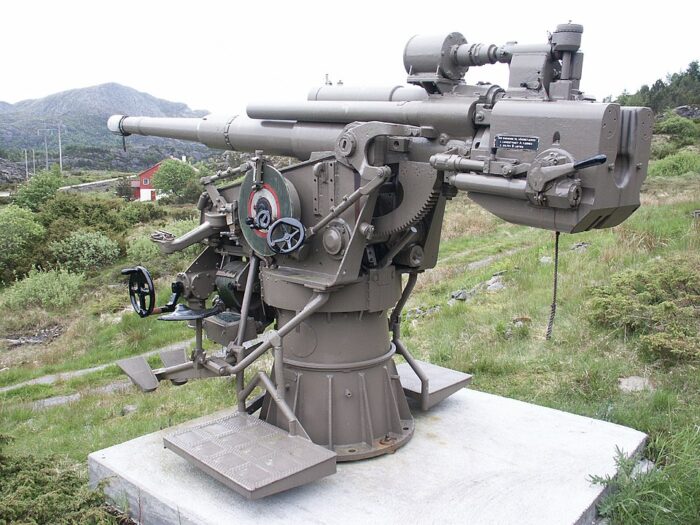
As built, the Type 1935 mounted a single 42-caliber 10.5 cm (4.1 in) SK C/32 gun on the aft deck.
Weight and size: 1,585–1,785 kgs (3,494–3,935 lb), 4.74–4.86 meters (15 ft 7 in – 15 ft 11 in)
Elevation: -10° to +50° on mount MPLC/32.
Shell: 15.1-kilogram (33 lb)
Muzzle velocity: 785 m/s (2,580 ft/s)
Range: 15,175 meters (16,596 yd) at 44.4°.
100 shells were provisioned.
3.7-cm FLAK C/30
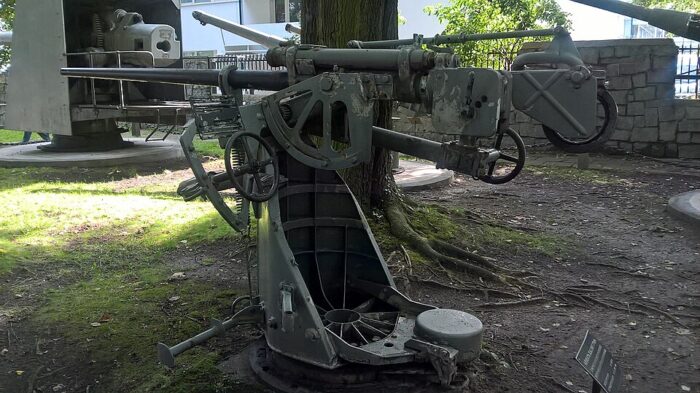
Anti-aircraft defense was provided by a single 80-caliber 3.7 cm (1.5 in) SK C/30 anti-aircraft (AA) gun superfiring over the 10.5 cm gun. Hand-operated mount, superfiring over the 10.5 cm gun aft.
Maximum elevation: +80°
Ceiling: 6,800 metres (22,300 ft)
Range: 8,500 metres (9,300 yd)/35.7°.
Shell: 0.748-kilogram (1.65 lb)
Muzzle velocity: 1,000 m/s (3,300 ft/s)
Rate of fire: 30 rounds per minute.
2-cm FLAK C/30 (1931)
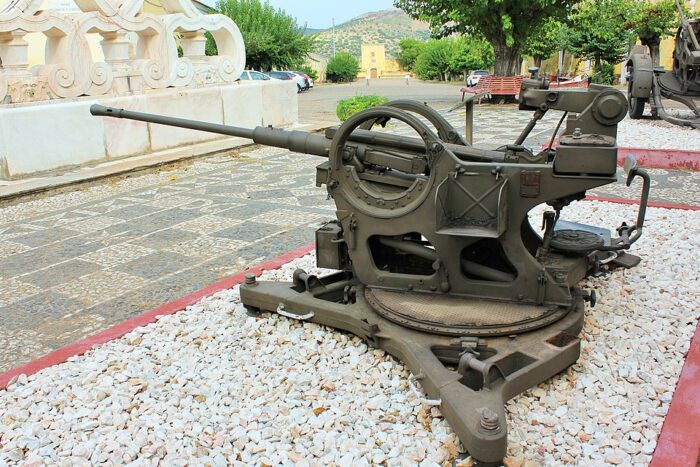
Two 2-cm (0.8 in) C/30 anti-aircraft guns were installed individual posts in the bridge wings forward. Each boat carried 2,000 rounds per gun.
Weight and size: 450 kg (990 lb), 4.08 m (13 ft 5 in).
Rate of fire: 120 rounds per minute practical, 280 cyclic.
Shell: 0.12-kilogram (0.26 lb) HE, muzzle velocity 875 m/s (2,870 ft/s)
Ceiling: 3,700 meters (12,100 ft)
Range: 4,800 meters (5,200 yd).
533 cm (21 inches) TTs
As completed, the two triple torpedo tube banks 53 cm (21 in) were compatible with all interwar models, in that case, the G7a torpedo:
G7a torpedo Specs
:
Weight: 3,369 lbs. (1,528 kg), Negative Buoyancy 605 lbs. (274 kg)
Dimensions: 23 ft. 7 in. (7.186 m)
Propulsion: Decahydronaphthalene (Decalin) Wet-Heater
Warhead: 617 lbs. (280 kg) Hexanite.
Guidance: Federapparattorpedo; 1944 Lagenunabhängiger Torpedo
Warhead: 300-kg (660 lb)
Speed/range settings: 14,000 m (15,000 yd)/30 knots; 8,000 m (8,700 yd)/40 kts; 6,000 m (6,600 yd)/44 knots.
Mines
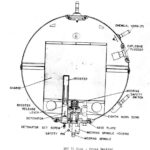 They could also carry now up to 60 mines, versus 30 on the Type 23/24. These were likely EMC Contact Mines, placed on trolley rails. Spherical mines, 44 inch (1.12 m) in diameter. Charge 661 lbs. (300 kg). 7 Hertz horns. Could be moored in 55, 109, 164 or 273 fathoms (100, 200, 300 or 500 m). First captured by the British in October 1939. more on navweaps
They could also carry now up to 60 mines, versus 30 on the Type 23/24. These were likely EMC Contact Mines, placed on trolley rails. Spherical mines, 44 inch (1.12 m) in diameter. Charge 661 lbs. (300 kg). 7 Hertz horns. Could be moored in 55, 109, 164 or 273 fathoms (100, 200, 300 or 500 m). First captured by the British in October 1939. more on navweaps
Armament Upgrades (1941-44)
The bridge wing single mounts were replaced dual mounts in 1943–1944. By January–February 1944, T22, T23, T24 and T27 received even Flakvierling mounts instead of their dual ones. They were also fitted with a FuMB7 “Naxos”, FuMB8 “Wanz G” radar detectors and had a new 2-meter (6 ft 7 in) rangefinder located on the former searchlight platform amidships. The alternative was a FuMO 63 K Hohentwiel radar on the searchlight platform. Until 1945 they ended with a fully updated radar and radar detectors panoply. In 1944–1945 their anti-aircraft suitevaried per ships, with alternative 3.7 cm Flak M42 or Flak M43, and even a 4 cm (1.6 in) Bofors guns replacing the bridge wing guns. T33 and T36 probably kept their twin-gun 2 cm mounts forward of the bridge.
Sensors (1944)
S-Gerät Sonar
This device could be inclined 80 up and down and also sideways and was stated to have a range of 400 metres. This was the standard light sonar common to light vessels and U-Boats.
FuMo 21 Radar
The FuMO 21 (Funkmess-Ortung, “Radio-direction finder, active ranging”) designed in 1941 became the main search radar installed from light cruiser down to torpedo boats. It was derived from the Seetakt search radar with a bedframe antenna 2 m × 4 m (6 ft 7 in × 13 ft 1 in). Range was quite limited however and beyond the range of capital ship gunnery. But it was of some use for close encounters by night and fog.
Specs:
Frequency 368 MHz/81.5 cm, PRF 500 per second (8 kW power)
Pulsewidth 5 μs, Range 10 nmi (19 km; 12 mi) prec ±70 m (230 ft)
FuMB7 “Naxos”
The Naxos radar warning receiver was a countermeasure to S band microwave radar produced by a cavity magnetron of the allies. It was installed from September 1943, replacing the Metox incapable of detecting centimetric radar. The FuMB 7 Naxos U was in general installed on U-boats, offering early warning of RAF Coastal Command patrol approaching with their ASV Mark III radar.
FuMB8 “Wanz G”
No data yet.
FuMO 63 K Hohentwiel
FunkMessOrtung. Active Radar. Could be detected. Small type, Hohentwiel-K. The FuMO 63 Hohentwiel-K generally replaced the aft searchlight on its platform, and a FuMB 6 Palau on a yardarm was found of the foremast with a passive array consisting of four fixed Sumatra dipoles situated around the forward searchlight sponson.
FuMB Ant 4 “Sumatra”
FunkMessBeobachtung: Passive Radar detector. Broad-band diagonal antennas. 1943, broadband dipole. It has flat, drop-shaped branches mounted in front of a reflecting area. In order to receive horizontally as well as vertically polarized waves, the dipole is tilted. Its reception angle is +- 50 degrees. To be able to survey the whole area, the antennas of the Sumatra installation are mounted on all four sides of the ship.
FuMB 6 Palau
This large matress style radar was installed on the tripod’s main leg foremast spur. A smaller FuMB 3 Bali was generally installed above.

Conways profile, HD illustrations awaited.
⚙ Type 1939 specifications |
|
| Displacement | 1,294 t (1,274 long tons) (standard) |
| Dimensions | 102.5 x 10 x 3.22 m (336 ft 3 in x 32 ft 10 in x 10 ft 7 in) |
| Propulsion | 2 shafts geared steam turbine sets, 4× water-tube boilers: 32,000 shp (24,000 kW) |
| Speed | 33.5 knots (62.0 km/h; 38.6 mph) |
| Range | 2,400 nmi (4,400 km; 2,800 mi) at 19 knots (35 km/h; 22 mph) |
| Armament | 4× 10.5 cm, 2×2 3.7 cm AA, 1×4, 2×1 2 cm AA, 2×3 533 mm TTs, 30–60 mines, 4× DCT |
| Sensors | S-Gerät sonar, FuMO 21 radar |
| Crew | 206 |
Assessment
The first eight boats in class, T 22 to T 29, were sent to the French coast for local operations after completion from 1942 to early 1944, notably to the dangerous Bay of Biscay and English Channel, to escort U-Boote, blockade runners and merchant ships, and were even more often deployed than large destroyers. For the British, who were already preparing to invade France, these ships posed a threat to the invasion fleet. Therefore, they attempted to eliminate all type 39s on the coast. The first of such operations however ended in disaster with the loss of the cruiser Charybdis, but they were nevertheless successful in the long run. Five were lost in action. After the invasion, only T 28 returned to Germany.
T 22 and T 23 had already been sent to Germany for refit. These three remaining boats and the subsequent newbuilds T 30 to T 36 had the Baltic Sea as their new operational area for minelaying operations, artillery support for the army, and ultimately the evacuation of soldiers and civilians from the Red Army until the end of the war. The T 36 participated in the rescue operation of the shipwrecked Wilhelm Gustloff on January 30, 1945. During a minelaying operation in Narva Bay in the Gulf of Finland on August 18, 1944, the T 22, T 30, and T 32 encountered a minefield of their own and sank, resulting in the loss of many of their crews. The T 23 and T 28 remained in service with the French Navy after the war until 1954/55.
Succession: The Type 41 (1944)

Class: T37 to T50: 14 boats planned, 5 to 96% complete on V Day.
In September 1939 the war caused the cancellation the bulk of Type 39 torpedo boats orders, with only 15 retained. Labor and material shortages also hampered their construction which dragged on until really starting by 1941. To compensate for the destroyers losses and spare strategic materials and labour time, the Kriesgmarine championed the idea in 1941 on a slightly enlarged Type 39 with an improved more propulsion machinery to reclaim 34 knots and more space to accomodate extra 3.7-centimeter (1.5 in) AA twin mounts.
Starting with the T 37, construction shifted indeed to the further developed and enlarged Fleet Torpedo Boat of 1941, which primarily received a more powerful propulsion system and diesel generators for power generation. None of the boats entered service. The four boats launched were loaded with poison gas munitions by the victorious allies after the war and sunk in the Baltic Sea.
In the end, the new Type 1941 reached 106 meters (347 ft 9 in) long for a 10.7 meters (35 ft 1 in) beam and 1,493/2,155 long tons displacement. They also had widely separated machinery spaces and 13 watertight compartments, 69% long double bottom. Using the same Wagner geared steam turbines and water-tube boilers they reached 40,000 shp (instead of 32,000) and carried 559 metric tons of fuel oil for 2,800 nautical miles. This was considered not good enough to replace destroyers and Schichau started work on an electric auxliary machinery, that was planned for the Type 1944, reaching 4,200 nm this time.
The main armament was essentially the same as the former Type 39, with four single 10.5 cm (4.1 in) guns (Although the KM44 dual purpose was planned to replace these), twin 3.7 cm a quadruple and two single 2 cm AA, same two triple torpedo tubes banks and four depth charge launchers. They also were to be fitted with the same S-Gërat sonar, but also the FuMO 21 radar, FuMB7 “Naxos” plus FuMB8 “Wanz G” radar detectors. Construction was postponed at Schichau until the first were laid down in October 1943, Fabruary and June 1944 and in 1945.
None was completed. When captured by the allies, hulls were between 5% (T50) and 96.5% for T37, the lead boat. T38 and 39 were 84 and 76% respectively, both captured and scuttled by the British in 1946 while T37 went to the US for evaluation, in 1946. All the remainder were BU on slipway, but T40 that was launched and towed while in completion, accidentally ran aground on 12 March 1945, and was later scuttled by the British Forces.
As for the type 1944, a 1400t standard design, it combined turbines and boilers with electric engines for 52000 hp and was armed with two TT banks, two twin DP 105mm guns and extra FLAK. These remained as paper projects, from T52 to T60, albeit the were all ordered to various yards, but never laid down. Postwar, the Bundesmarine will return to the torpedo boat type though a serie of fast attack crafts extrapolated from WW2 S-Boote.
Planned Caracteristics:
Displacement: 1,493t standard, 2,155t deep load
Dimensions: 106 x 10.7 x 3.72 m (348 x 35 x 12 ft)
Propulsion: 2 shafts turbines, 4× WT boilers, 40,000 shp (30,000 kW)
Speed: 34 knots (63 km/h; 39 mph)
Range: 2,800 nmi (5,200 km; 3,200 mi) at 19 knots
Crew: 210
Armament: 1× 10.5 cm (4.1 in), 3×2 37mm, 8x 20mm, 2×3 500 mm (19.7 in) TTs, 4 DCT
Gallery (WoW)
Career of the Type 1939
 T22
T22
Originally ordered as a Type 37 torpedo boat (same story for the others) on 30 March 1939, T22 was reordered on 10 November from Schichau as a Type 39. Like all the class she came from Elbing, East Prussia (hence the allied monicker “elbing class”) in yard number 1481. She was launched in 1941 and commissioned on 28 February 1942. After working up she trained in the Baltic with KMS Scharnhorst, light cruisers Leipzig and Nürnberg, destroyers Z25, Z31 and Z37, TBs T17, T20, T21, Falke and Kondor, on 1–3 October 1942. She was transferred to France with T23, Falke and Kondor to escortblockade runnes and U-Boats. The first mission was the Italian blockade runner SS Cortellazzo heading from Bordeaux through the Bay of Biscay, on 29–30 November. This was a success,, but not the next Himalaya escorted by T22, T23, Kondor, T2 and T5. The break through failed under relentless British air raids. On 5–8 May, the 2nd Torpedo Boat Flotilla (T22, T2,T5,T18,T23) laid three minefields in the Channel. She was assigned to the 5th Torpedo Boat Flotilla (TBF) with T22, Kondor, Falke, Greif and Möwe to lay two more minefields in the Channel on 4–6 June 1943.
Next she escorted escort U-boats through the Bay, back in the 4th TBF. On 2 August, T22, T24 and T25, rescued men from badly dampaged and later sunk, evacuated U-106. From 29 to 31 August she escorted the Japanese submarine I-8 through the Bay, to Lorient. She was in distant cover for a small convoy on 3/4 October 1943 when stumbling on five British destroyers, leading to the Sept-Îles Battle off Brittany. Their first volley of five torpedoes missed, but initially they were not spotted, and only when T23 turned her radar to determine a better range the latter detected the radar and altered course to dodge all six torpedoes from T22 alone miss. Two pursued the retreating Germans and disangaged after being hit by German gunfire.
On 22 October, the 4th Flotilla (T22, T23, T25, T26 and T27) left Brest in provide cover for the blockade runner Münsterland bound for Japan. They also escorted the 2nd Minesweeping Flotilla in the Channel. On the night of the 23rd, the RN sent the light cruiser Charybdis, destroyers Grenville, Rocket, Limbourne, Wensleydale, Talybont and Stevenstone. T22’s hydrophones detected them off the Sept-Îles at 00:25. Korvettenkapitän Franz Kohlauf manoeuverd in interception and Limbourne got the radio transmissions at 01:20. At 01:36 Charybdis’s radar detected them from 8,100 yards (7,400 m), firing star shells. She was spotted, silhouetted against the lighter horizon. Kohlauf a general torpedo fire, all at once. Two struck the cruiser which sank quickly. Two from T22 reased the bow off HMS Limbourne, later scuttled. The loss of the flagship created enough confusion for the German TBs to successfully disengage. This was heralded back home by Goebbels as a great victory.
On 24–26 December, T22 escorted the 6,951 GRT blockade runner MV Osorno through the Bay of Biscay and the trailing 2,729 GRT refrigerated cargo ship MV Alsterufer, with 4th and 8th Destroyer Flotillas cerving them from 27 December through the Bay. Code-breaking efforts allowed the allies to sent an amlbushing force of cruisers and prepared aircraft for a showdown in the Western Atlantic: Operation Stonewall. A B-24 Liberator from No. 311 Sqn. RAF later spotted and sank Alsterufer. Since she was out of view, the TB flotilla were unaware of this, and continued onward to the rendezvous point, only to be spotted by another Liberator on the 28th. The light cruisers Glasgow and Enterprise were vectored in. The encounter happened in bad weather, rough seas throwing sea spray over the TBs decks. Glasgow spotted them by radar and open fire at 13:46 from 19,600 meters (21,400 yd), Enterprise followed a few minutes later. Soon after, believed to be at range, the TBs fired guns and launched all torpedoes, which missed apart one that hit Glasgow’s forward boiler room at 14:05 (QF 2-pdr destroyers, 2 killed, 6 wounded). Kapitän zur See Hans Erdmenger at the head of the 8th Flotilla ordered to split with Z23, Z27, T22, T25 and T26 sailing north at 14:18. Enterprise found her mark on Z27, Glasgow on T25 and then T26. T22 atempted to rescue T25 and fired her remaining torpedoes at Glasgow at 14:58 but missed. Glasgow soon found her mark on her, so T22 laid a smoke screen and retired. She later met Z23 and made it at Saint-Jean-de-Luz (Basque country) for emergency repairs.
In early February 1944, T22 and T23 crossed the Channel back home. T22 began was overhauled at Elbing until June 1944. She was reassigned to the 6th TBF in the Baltic (T22, T30, T32) and sortied to lay a minefield in Narva Bay (Estonian coast) on 17/18 August. Later T23 joined in and they laid 54 mines each in Helsinki. After midnight T30 struck mines at 00:25, knocking out all power, then T32 followed, lost her bow, disabled her engines. At 00:30 T30 exploded and broke in half after drifting to another mine. T22 also struck two mines while atempting to assist T32, she sank at 01:14 with 143 men.
 T23
T23
T23 was reordered on 10 November 1939, laid down on 1 August 1940, launched on 14 June 1941 and commissioned on 14 June 1942. She was transferred to France and escorted the blockade runner SS Cortellazzo from Bordeaux in the Bay of Biscay on 29–30 November but failed to protect Himalaya on 30 March 1943 (see above). She repeated the escort with the same on 9–11 April, alongside T2, T5 T22, Kondor, thwarted by air attacks again. On 5–8 May she laid three minefields in the Channel. Next she escorted U-boats in July and was in distant cover of a small convoy on 3/4 October, the 4th Flotilla spotting five British destroyers off the Sept-Îles (Brittany), a brief clash in the dark from which she escaped unscaved.
Next on 22 October 1942, she was sent to cover the unladen blockade runner Münsterland coming back from her mission whole escorting the 2nd Minesweeping Flotilla for a mission in the Channel. Charybdis and Grenville as well as five DDs sallied out, and the battle developed at 00:25. Around 01:36 T23 spotted Charybdis. Both her and Limbourne were hit by torpedoes, “shared” by all TBs. She then successfully disengaged from the Battle of Sept Iles.
On 24–26 December, T23 escorted the 6,951 GRT blockade runner MV Osorno in the Bay of Biscay with the MV Alsterufer trailing her by several days. The other escort were the four destroyers of the 8th DF, six TBs of the 4th Flotilla including herself, leaving on 27 December. The Allies launched Operation Stonewall. A B-24 sank Alsterufer and the Germans were unaware of it and sailed to the RDV point in worsening weather. Spotted by a Liberator on the 28th they were on an interception course by Glasgow and Enterprise. Glasgow started firing from 19,600 meters (21,400 yd) followed by Enterprise. The DDs missed albeit Glasgow was damaged at 14:05 and the senior captain on the German side at the head of the 8th Flotilla ordered to split up. Later Z27, T25 and T26 were all sank but T23 was part of the souther group and disengaged unscaved.
By early February 1944, T23 and T22 crossed the Channel back to Germany. T23 had a well awaited overhaul and modernization at Bremen until June. She joined the 5th Torpedo Boat Flotilla in the Baltic, attached to the 6th TBF to lay mines in Narva Bay on 17/18 August and off Helsinki in Finland. They departed on the 17th and shortly after midnight started to lay their mines when T30 struck two mines at 00:25. Jus a minute afterwards, T32 also struck two mines. She lost her bow clean off, lost all power. T22 jettisoned her mines to clear the quarterdeck in an attempt of towing T32, but as she approached at 00:30 they could see T30 exploding after drifting on another mine. At 00:40 T22 signaled T32 and approach to try towing her but at 00:50 she struck two mines in turn. 4 minutes later, lookouts reported a MTB approaching fast aft, confirmed by hydrophones. Korvettenleutnant Weinlig ordered T23 to withdraw and radioed for shallow-draft boats to pickup survivors. At 01:50, T23 met U-679 and nearly attack until recoignizing her id signal.
On 20–21 August 1944 with T28 she escorted the heavy cruiser Prinz Eugen for a bombardment near Tukums in Latvia. She laid minefields in the Gulf of Finland and on 22 October, still with T28 she bombarded Soviet positions near Sworbe, Saaremaa. In November she provided support for the Soviet attack of 19 November. By mid-December she escorted the 6th Destroyer Flotilla (Z35, Z36 and Z43) laying mines between the Estonian coast another outer minefield. On the 11th the weather deteriorated and navigation was hard. In the north, Z35 and Z36 blundered into the Nashorn minefield and sank.
Prinz Eugen, 2 DDs, T23 and T28 supported another counterattack near Cranz (East Prussia) on 29–30 January 1945. Next she escorted Admiral Scheer with T28 and T35 off the East Prussian coast on 2–5 February, on Frauenburg and to cover the 4th Army on 9–10 February. T23 and T28 screened Lützow on such a mission on Danzig on 27 March 1945. She then escorted evacuation convoys from Hela in April. On 5 May she helped a 45,000 refugees evacuation to Copenhagen and was back to escort 20,000 more to Glücksburg. The war ended as she was underway.
Postwar she was was allocated to the British, then to France on 4 February 1946. Renaled L’Alsacien she had an overhaul in Cherbourg with US Radars and Bofors, being recommissioned in December 1949 assigned to the Mediterranean Aircraft Carrier Group (Arromanches and Dixmude) at Toulon, then the ASW Group until strickon on 9 July 1954 and sold.
 T24
T24
Originally ordered as a Type 37 torpedo boat on 30 March 1939, T24 was reordered on 10 November 1939 from Schichau. The boat was laid down on 21 September 1940 at their Elbing, East Prussia, shipyard as yard number 1483, launched on 13 September 1941 and commissioned on 17 October 1942. She worked out until March 1943, was sent to Norway for escort duties and bacl for a refit at Kiel. On 3 July with T25 she was sent though the Channel to Western France. On 5 July, she were attacked underway by three Dutch-manned MTBs as well as British coastal artillery. When in Boulogne they was a Hawker Typhoon raid on 6 July. They were unscaved. After midnight they left on 7 July for Le Havre and on 9/10 July while between Saint-Malo and Brest, they started their distant cover for a convoy of five minesweepers off Ushant. They were ambushed by RN destroyers Melbreak, Wensleydale and the Norwegian Glaisdale. One minesweeper was sunk, another damaged and T24 and T25 arrived too late, but still managed to damaged Melbreak before they disengaged. She was assigned to the 4th TBF and tasked to protect U-boats through the Bay. On 2 August with T25 and T22, she rescued men from U-106. From 29 to 31 August they escorted I-8 through to Lorient.
On 24–26 December T24 escorted the 6,951 GRT blockade runner MV Osorno through the Bay with MV Alsterufer trailing by several days with the 8th DF and 4th TBF sailing out on 27 December to join. Operation Stonewall was launched, Alsterufer was sunk. See above for details. In the Battle of Biscay she was part of the splitted force with the southern group, and disengage.
On the night of 21/22 April 1944 her unit (T24, T27, T29) was transferred from Cherbourg to Saint-Malo and was off the Sept-Îles on 25/26 April, when engaged by HMS Black Prince, escorted by HMS Ashanti, HMCS Athabaskan, HMCS Haida and HMCS Huron (Tribal class DDs) off the Île de Batz. They were briefly engaged by German coastal artillery. Korvettenkapitän Franz Kohlauf was in search for them but were spotted first by Black Prince’s radar from 21,000 yards (19,000 m) at 02:07. They reversed course but with their slower speed, the Allied caught them and started firing from 13,000 yards (12,000 m) by 02:20 after Black Prince began fired star shells. T24 and T27 answered from 9,000 yards (8,200 m). Black Princehad one of her forward turrets jammed but still their fire was accurate. T27 was hit at 02:31, fell to 12 knots (22 km/h; 14 mph) with Kohlauf ordering her into Morlaix Bay. Allied Radar were less efficient so close to the coast. T24 fired her aft torpedo tube, missed, but was hit by two shells in her superstructure. She fired her remaining torpedoes at 02:54, missed. T29 was also hit and lost her rudder. Ashanti and Huron then focused and sank her. Haida and Athabaskan chased T24 but disengaged as she was close enough from Saint-Malo, for the batteries to open fire.
After emergency repairs, T27 joined T24 in Saint-Malo during on 26/27 April, and they departed for Brest on 28/29 April, spotted by British coastal radar, intercepted by Haida and Athabaskan off Île Vierge. Haida fired a star shell at 04:12 but the germans laid a smoke screen and turned away, firing all their torpedoe. T24 hit Athabaskan, which later blew up, probably from a magazine explosion, sank at 04:42. Haida pursued T27 and badly damaged her and so close to the reefs she accidentally ran aground. The Canadians continued to pummel her until she burned from stern to stem. She returned to rescue survivors from her sister. T24 and two minesweepers later tried to pull T27 off and failed. T24 rescued 47 survivors from Athabaskan before heading to Brest but struck a mine en route, causing only light damage. The 4th TBF was disbanded, she was sent to the 8th DF (mixed unit with destroyers and Type 39 TBs). After repairs she sailed for Cherbourg on 19 May, struck another mine and ended in repairs for more weeks.
On the night of 8/9 June the 8th Flotilla headed for Cherbourg, when intercepted by 8 Allied destroyers (10th DF) in what became the Battle of Ushant. The Germans were spotted first, fire at, answering by a four-torpedo salvo from each destroyer, missing. T24 was trailing in the formation, saw no targets. British fire badly hit Z24, and the range fell to the point tehy used their 40 mm (Bofors and 3.7 cm. Z24 laid smoke and disengage followed by T24. Haida and Huron stopped as they passed over a British minefield, lost track. Z24 and T24 reversed course but later received permission to return to Brest.
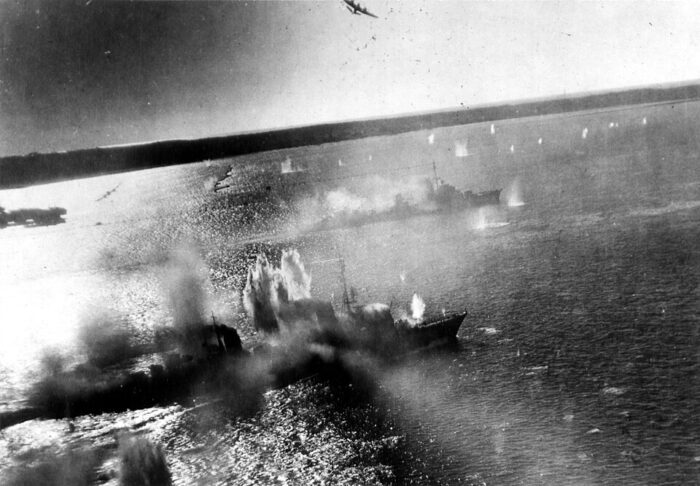
T24 and Z24 under attack by Beaufighters at Le Verson sur Mer, Gironde estuary 24 August 1944
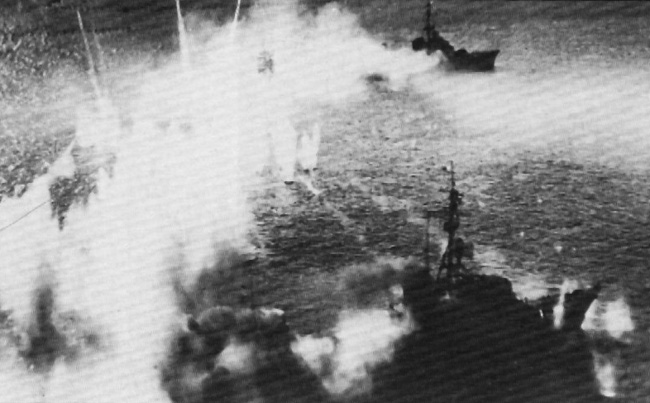
T24 (foreground) and Z24 under attack, 25 August
On the night of 14/15 August, T24, 2 minesweepers and Sperrbrecher 157 escorted the aviation tender and repair ship Richthofen when attacked by HMS Mauritius and DDs HMS Ursa and HMCS Iroquois, off Les Sables d’Olonne. She laid a smoke screen, launched torpedoes and nearly hit Iroquois which didged them. She was hit once in return, but efforts were on Sperrbrecher 157 and Richthofen with a minesweeper sank, the other beached. Iroquois was lightly damaged. T24 took refuge at Le Verdon-sur-Mer and when underway on 24 August with Z24 she was attacked by Bristol Beaufighter from No. 236 Sqn. RAF and No. 404 Squadron RCAF. T24 took a rocket broadside and was so badly damaged she was later abandined and sank with 18 dead. Z24 was also so badly damaged she sank a day later.
 T25
T25
T25 was reordered on 10 November 1939, laid down on 30 November 1940 at yard number 1484, launched on 1 December 1941, commissioned on 12 November 1942. She trained until June 1943, on 3 July she joined T24 to Western France. On 5 July she was attacked by MTBs and coastal artillery underway. In Boulogne and attack by Hawker Typhoon on 6 July left her unscaved. On 7 July she depareted and arrived at Le Havre. On 9/10 July underway between Saint-Malo and Brest, she was ordered as distant cover for a convoy of 5 minesweepers off Ushant later attacked by Melbreak, Wensleydale and Glaisdale. T25 and T24 arrived later but managed to heavily damaged Melbreak. In the 4th TBF she started escorting U-boats through and on 2 August rescued men from U-106, on 29-31 August, escorted I-8 to Lorient. She laid minefields in the Channel on 3-5 September, provided distant cover on 3/4 October, in what became the 1st Battle of Sept-Îles, she was unscaved and disengaged.
On 22 October, with T22, T23, T26, T27, she left Brest to reach Münsterland escorting the 2nd Minesweeping Flotilla and were later intercepted by Charybdis and 5 DDs (see above). In this second battle of Sept-Îles T25 performd poorly due to her partially trained torpedo officer, she missed the chance to fire her torpedoes and later disengaged.
Next she also took part in the Battle of the Bay of Biscay on 24–26 December (see above again) for MV Osorno and MV Alsterufer, combining the 4th TBF and 8th DF. The allies launched Operation Stonewall. When the german forces split, she followed Z23, Z27, T22, T25 T26 to the north at 14:18. Enterprise crippled Z27 and Glasgow engaged T25. At 14:54 she lost her aft torpedo tubes, Flakvierling and 3.7 cm guns, a turbine, with severed the oil pipes,so that she started to loose speed. Nex she lost her foremast and forward funnel, then all electrical power. At 15:10 she still fired her forward torpedoes. Her captain asked for help from T22 but Glasgow prevented this, switched to T26. T25 drifted and managed to restart a turbine. At 16:35 Enterprise closed to a range to 3,000 yards (2,700 m) and launched torpedes. On found its mark on T25 whch sank at 16:46 with the loss of 85 men. Survivors were later rescued by U-505 (34) and later a few more by the Irish merchantman MV Kerlogu, British minesweeper Seaham, two Spanish destroyers.
 T26
T26
T26 was reordered on 10 November 1939, laid down on 10 May 1941 at yard number 1485, launched on 26 March 1942, commissioned on 28 February 1943. She joined T27 for Western France on 30 August 1943. With Kondor, Greif and T19, they laid a minefield in the Channel on 29–30 September.
She then took part in the Battle of Sept-Îles on 22 October with the 4th TBF and T27, T22, T23 and T25. Long story short (see above), she managed do disengaged after their torpedoes found their mark on a cruiser and DD. Later she also took in the Battle of the Bay of Biscay on 24–26 December. T26 escorted the 6,951 GRT blockade runner MV Osorno. Operation Stonewall was launched, MV Alsterufer was sunk, but her unit proceeded to the RDV plan with the 8th DF. After the fight started with Glasgow and Enterprise, Kapitän zur See Hans Erdmenger, orded to split forces. T26 was in the group of Z23 and Z27, T22, T25 to the north at 14:18. Z27 and T25 were later both sunk and both cruisers concentrated on T26. She was sunk by a torpedo from Enterprise after a dulge of shells which lef her dead in the water, at 16:00. She foundered with 90 crewmen. Survivors were later rescued but numbers are unknown.
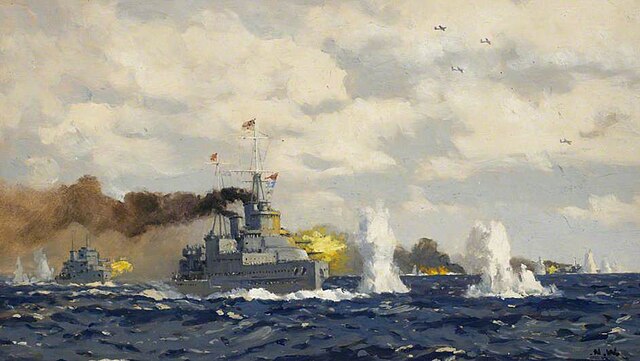
Battle of the Bay of Biscaye, 28 Dec. 1943
 T27
T27
T27 was reordered on 10 November 1939, laid down on 2 July 1941 at yard number 1486, launched on 20 June 1942, commissioned on 17 April 1943. She joined after the usual weeks of training, T26 for Western France on 30 August 1943. With Kondor, Greif and T19, she laid a minefield in the Channel on 29–30 September. On 22 October 1943 she took part in the Battle of Sept-Îles. Like the others she managed to escape. Next she was at the Battle of the Bay of Biscay on 24–26 December. She as ordered by Hans Erdmenger (8th Flotilla) to join the southern group, which successfully disengage.
She also later took part in the Action of 26 April 1944. The night of 21/22 April with the 4th Flotilla (T27, T24, T29) she was transferred from Cherbourg to Saint-Malo, laid a minefield off the Sept-Îles on 25/26 April, but was soon engaged by HMS Black Prince and 4 Tribal class DDs off the Île de Batz (see above). Long story dhort, the Allied fire was accurate T27 was hit at 02:31 with her speed falling to 12 knots (22 km/h; 14 mph). Kohlauf ordered her into Morlaix Bay and she managed to escape due to allied radar reflection on the rocks of the bay.
After emergency repairs, she joined T24 in Saint-Malo on 26/27 April, then sailed for Brest on 28/29 April when spotted by British coastal radar and intercepted by Haida and Athabaskan off Île Vierge. The two TBs fired all of torpedoes, turned, hit Athabaskan. Haida concentrated on T27 and she hit her at least seven times. She was soon on fire, lost most of her armament. While trying to reach Aber Wrac’h, she ran aground. Haida continued and at some point ighited a 2 cm ready-use ammunition on the bridge wings, and then left to rescue Athabaskan’s survivors. T27 lacked power to put the fire out, so she was abandoned at 04:35, with 11 men killed. An attempt later to pull her off failed but all 83 crewmen were saved. Later British motor torpedo boats and aircraft finished off her wreck in early May 1944.
 T28
T28
Ordered on 10 November 1939, T28 was laid down on 24 September 1941 at yard number 1487, launched on 8 October 1942, commissioned on 19 June 1943. She had weeks to work up before joining T29 for Western France by late January 1944. In the channel, they were shelled by British coastal artillery, attacked by Fairey Albacore. One near-miss caused some minor leaks on T28’s boiler room, taking splinter damage. After a refit upon arrival until early June, the Normandy landings had the 5th TBF (T28, Falke, Jaguar, Möwe) mobilized, making multiple sorties from Le Havre but failed to sink significant Allied shipping, after launching 50 torpedoes and many shells. To their credit they sank the Norwegian destroyer HNoMS Svenner on 6 June. T28 was not damaged during the air raid on 14/15 June which claimed Falke and Jaguar. On 21/22 Jul she escorted three E-boats from Le Havre to Boulogne, and had a brief action with HMS Melbreak en route. She was back in Germany on the 27th after many failed attacks.
On 20–21 August T28 and T23 escorted Prinz Eugen in support of the counterattack near Tukums. She took part in the evacuation of Tallinn by mid-September 1944 and helped to lay additional minefields in the Gulf of Finland. On 22 October she took part in the bombardment near Sworbe. She later provided support on 19 November, and by mid-December, joined the 6th Destroyer Flotilla (Z35, Z36 and Z43) with T23 to lay a new minefield but in bad weather, Z35 and Z36 went off course blundered into the Nashorn minefield. T28 was refitted in Gotenhafen in October-December and later escorted Prinz Eugen, two destroyers, for a counterattack near Cranz on 29–30 January 1945. Next she escorted Admiral Scheer with T23 and T35 on 2–5 February and again for a bombardment near Frauenburg on 9–10 February. She then screened Lützow for a bombardment south of Danzig on 27 March. She then screened evacuation convoys from Hela in early April and on 5 May, helped to ferry 45,000 refugees from East Prussia to Copenhagen and then Glücksburg on the 9th. She was later informed of the cessation of hostilities.
She was allcated to Britain but then passed on to france on 4 February 1946, renamed “Le Lorrain”, modernized in Cherbourg, recommissioned in December 1949, assigned to the Aircraft Carrier Group, Mediterranean Squadron, then ASW group, and ended as trials ship due to the lack of spares until stricken on 31 October 1955 and sold.
 T29
T29
T29 was reordered on 10 November 1939, laid down at Elbing yard number 1488, commissioned on 21 August 1943. T29 and T28 were sent to Western France by late January 1944 and were attacked en route by British coastal artillery and two British Fairey Albacore but she was unscaved.
She took part in the Action of 26 April 1944. The night of 21/22 April 1944 as part of the 4th TBF (T29, T24, T27) in Cherbourg she headed for Saint-Malo and laid a minefield off the Sept-Îles, north coast of Brittany on 25/26 April, retiring when engaged by HMS Black Prince and Tribal class ships off the Île de Batz. See above for detail. At 02:54 a shell disabled T29’s rudder. Ashanti and Huron concentrated on her hitting her stern, making her veering off-course, and closed the range setting her on fire, until it reached ammunitions, causing a tremendous explosion, blowing her forward torpedo mount overboard. Haida and Athabaskan could not catch T24 and went back to finish T29 off. Collectively they fored all 15 torpedoes but misses. Give the state of the torpedo boat, they paused to allow the surviving crew to abandon ship at 04:00. They then came closer to recover survivors when a single 2 cm gun opened fire, damaging Huron and Haida. The answer was punishing, all four concentrated their fire at point blank range, all 32 main guns, even AA guns, completely obliterating her hull. T29 disappeared at 04:20 with 137 crewmen with 73 rescued, all for a trigger happy gunner.
 T30
T30
T30 was reordered on 10 November 1939, laid down on 10 April 1942 at yard number 1489, launched on 13 March 1943, commissioned on 24 October 1943. After working up she was assigned to the 6th Destroyer Flotilla, laying minefields in Narva Bay by mid-April 1944. T30 and T31 supported Finnish forces in Vyborg Bay, Koivisto Sound as part of the Vyborg–Petrozavodsk Offensive. On 20 June they spotted and attack a group of Soviet motor torpedo boats, claimed 3–5 boats sunk albeit T31 received a torpedo, whocj broke her in two. Without unit, T30 was later assigned to the 2nd Torpedo Boat Flotilla (T8, T10) taking part in the failed attempt to recapture Narvi on 27/28 June with Finnish forces. The managed still to damage a Soviet patrol boat off Narva on 16 July. By August she was transferred to the 6th TBF (T30, T32, T22) tasked t lay a minefield in Narva Bay, night of 17/18 August. With T23 from the 5th TBF, she loaded 54 mines in Helsinki and sailed out on the 17th and arrived after midnight, laying their first mines when T30 struck a two at 00:25, knocking out all power. She started to list to port. A minute after, T32 also struck two mines blowing her bow off and also lost all power, dangerously drifting. At 00:30 T30 exploded and broke in half herself after drifiting on another mines, and sank with the loss of 137 crewmen.
 T31
T31
T31 was the first ordered as a Type 1939 (not reordered), on 20 January 1941, from Schichau, laid down at yard number 1513 in Elbing and launched in 1943, commissioned on 5 February 1944. She worked up and joined T30 to support Finnish forces in Vyborg Bay, Koivisto Sound (see above). They very much shared the same fate. On 20 June she battled Soviet motor torpedo boatsa and co-claimed singing between 3 and 5 of them sunk; but TKA 37 managed to place a well aimed torpedo which ripped off her flank. T31’s crew could not contain the flooding, probably caused by a hit right in the separation of the bulkhead, so she could not stay afloat with two adjacent compartment flooded. She rapidly capisized off Nerva island, with the loss of 82 crewmen.
 T32
T32
T32 was ordered on 20 January 1941 from Schichau and laid down on 27 October 1942 at yard number 1514, launched on 17 April 1943, commissioned on 8 May 1944. She Worked up until August, and was assigned to the 6th TBF operating in the Baltic with herself as flotilla leader, T22 and T30 under her. First mission was to lay a minefield in Narva Bay on 17/18 August. With T23 from the 5th TBF they loaded 54 mines in Helsinki and arrived after midnight, to start laying mines, when T30 bunderred into a pair of mines at 00:25 and lost all power, listing. A minute after this was T32, blow her bow clean off and knocking out her engines. At 00:30 T30 exploded and broke in half after drifting on another mine and T22 also truck two mines while maneuvering to go alongside T32. She blew up at 01:14 and sank, but T23’s unit commander still believed they were under torpedo attack, not mines. This was a fatal error, as he carelessely ordered his boat to leave the area without rescuing any survivors on T32. T32 was left there, only to be sunk by Soviet aircraft after dawn, loosing 137 crewmen. The Soviets never claimed to have torpedoed these and historian Michael J. Whitley stated this was probably a navigation error from T23 (the flotilla leader for the operation) that brought them in a German minefield. By night also it was impossible to spot these mines, just dormant under the surface.
 T33
T33
T33 was ordered on 20 January 1941 from Schichau and laid down at yard number 1515, launched in 1943, commissioned on 16 June 1944. She worked up and was deployed to support German forces in the Baltic. She escorted Prinz Eugen for the counterattack against advancing Soviet forces near Cranz on 29–30 January 1945. Later with two destroyers she bombarded Soviet positions near Kolberg on 11-18 March during the evacuation of the city. She then screened evacuation convoys from Hela, until April 1945. By 10 April, she towed the destroyer Z43 after striking a mine. On 5 May, she helped ferrying out 45,000 refugees to Copenhagen and then 20,000 more to Glücksburg on the 9th.
Postwar, she was allocated to the USSR. Assigned to the Baltic Fleet on 5 November and operational on 1st January 1946, and renamed Primerny on 13 February 1946, reclassified as destroyer. She joined the North Baltic Fleet, active until spare parts ran out until 30 November 1954, then converted into a floating barracks as PKZ-63 on 28 December, and transferred for scrapping on 9 November 1956 at Tallinn in 1957-1958. In 1946, the ship was the object of thourough studies. The design impressed the Soviet naval staff, which soon after influenced the design of the Kola class Frigates or Project 42 Sokol class.
 T34
T34
T34 was ordered on 20 January 1941 from Schichau, laid down on 5 March 1943 as yard number 1516, launched on 23 October 1943; commissioned on 12 August 1944 under command of Kapitänleutnant Freiherr von Lüttitz. She had a lengthy working up, with gunnery practice using the the radio-controlled target ship Hessen in the Baltic on 20 November, but she struck a mine laid by Soviet submarine L-3, sinking off Cape Arkona with the loss of 62 crewmen. This was the shortest career of any Type 1939.
 T35
T35
T35 was ordered on 20 January 1941, laid down on 20 April 1943 as yard number 1517, launched on 12 December 1943; commissioned on 7 October 1944. She worked up for several months, and in early 1945 escorted the heavy cruiser Prinz Eugen for the bombardment near Cranz on 29–30 January. No logs for her activities until 5 May, when T35 helped to ferry 45,000 refugees from East Prussia to Copenhagen and then 20,000 more to Glücksburg on the 9th. After V-day she allocated to the US after dividing the surviving ships by late 1945. T35 sailed for the US for testing, renamed DD-935, reflecting she was considered a destroyer. This is fortunate since most creative commons photos opf the Type 1939 comes from the ones taken of T35, now released in open source. After she was thoroughly examined, she was to be scrapped, but France, which operated two of them, requested her for spare parts. She was towed to France in 1947 and gradually cannibalized to maintain L’Alsacien and Le Lorrain until 1954. She was then stricken on 3 October 1952 and scrapped.
 T36
T36
T36 was ordered on 20 January 1941 from Schichau, laid down on 10 June 1943 as yard number 1518, launched on 5 February 1944, commissioned on 9 December 1944. She worked up for the next several months into 1945 ahd saw the same career as T35, escorting Admiral Hipper on 30 January 1945 for a rendezvous with an evacuation convoy including Wilhelm Gustloff (worst tragedy of WW2) wit an estimated 10,000+ refugees and troops from East Prussia in Operation Hannibal. Famously the liner was torpedoed by S-13. T36 depth-charged the submarine, and managed to pick up a meagre 564 survivors, landed at Sassnitz. Next she escorted Admiral Scheer with T23 and T35 off East Prussian on 2–5 February and by early March, she screened her again when she bombarded Soviet forces at Wollin Island. She then screened evacuation convoys from Hela by early April and herself too 150 people on board on 3 May. Back to Hela and a last time she was laden with refugees for Copenhagen the following day when she struck a mine off Swinemünde and was seen drifting, sunk the following day by Soviet aircraft.
Gallery (T35, all)
Read More/Src
Books
Campbell, John (1985). Naval Weapons of World War II. Annapolis, Maryland: Naval Institute Press (NIP).
Friedman, Norman (2011). Naval Weapons of World War One: Guns, Torpedoes, Mines and ASW Weapons of All Nations.
Gröner, Erich (1990). German Warships 1815–1945. Vol. 1: Major Surface Warships. NIP
Haarr, Geirr H. (2010). The Battle for Norway – April–June 1940. Barnsley, UK: Seaforth Publishing.
Haarr, Geirr H. (2013). The Gathering Storm: The Naval War in Northern Europe September 1939 – April 1940. NIP
Haarr, Geirr H. (2009). The German Invasion of Norway, April 1940. NIP
Rohwer, Jürgen (2005). Chronology of the War at Sea 1939–1945: The Naval History of World War Two (Third Revised ed.). NIP
Sieche, Erwin (1980). “Germany”. In Chesneau, Roger (ed.). Conway’s All the World’s Fighting Ships 1922–1946.
Whitley, M. J. (2000). Destroyers of World War Two: An International Encyclopedia. London: Cassell & Co.
Whitley, M. J. (1991). German Destroyers of World War Two. NIP
Links
on navypedia.org
on german-navy.de/
avalanchepress.com
german-navy.de
german-navy.de/kriegsmarine/ torpedoboats T1935/
on drivethrurpg.com/
navweaps.com german weaponry
en.wikipedia.org Type_39

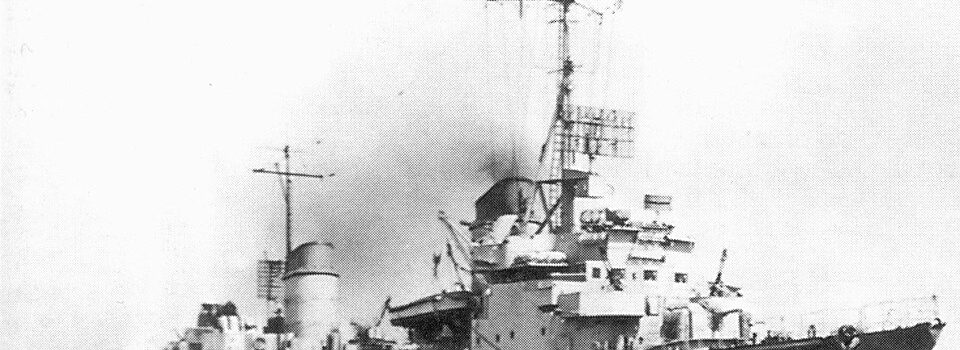



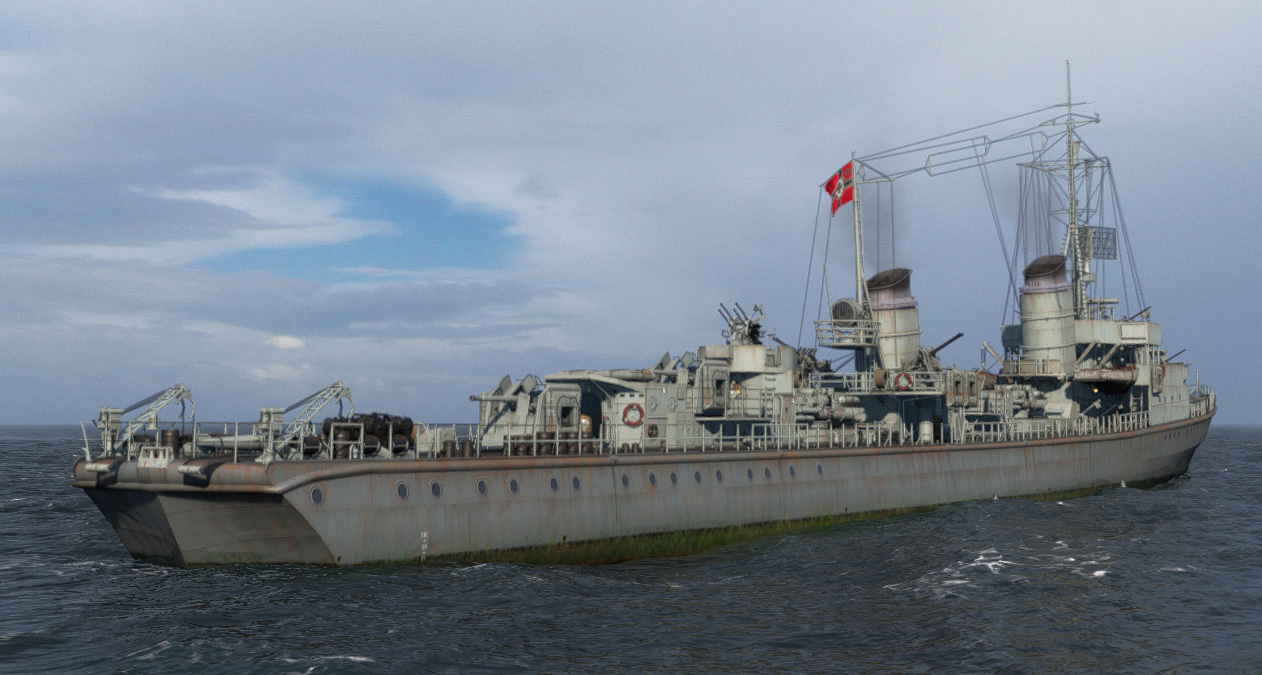



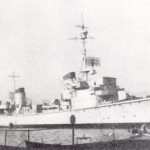
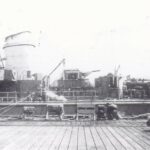
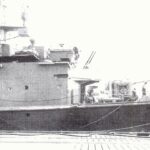
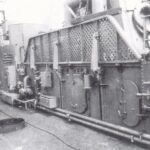
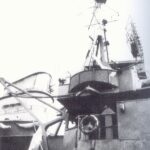
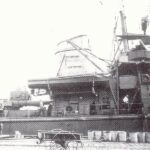
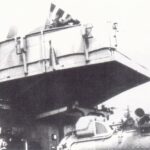
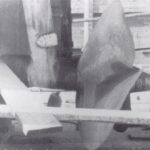
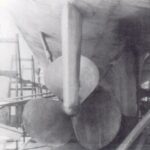
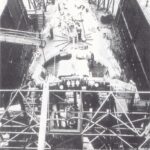
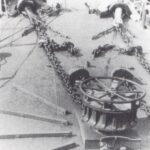
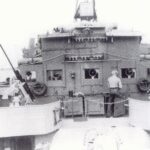
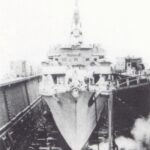
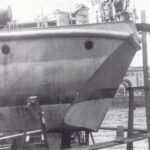
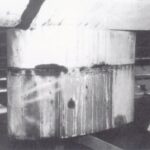
 Latest Facebook Entry -
Latest Facebook Entry -  X(Tweeter) Naval Encyclopedia's deck archive
X(Tweeter) Naval Encyclopedia's deck archive Instagram (@navalencyc)
Instagram (@navalencyc)





 French Navy
French Navy Royal Navy
Royal Navy Russian Navy
Russian Navy Armada Espanola
Armada Espanola Austrian Navy
Austrian Navy K.u.K. Kriegsmarine
K.u.K. Kriegsmarine Dansk Marine
Dansk Marine Nautiko Hellenon
Nautiko Hellenon Koninklije Marine 1870
Koninklije Marine 1870 Marinha do Brasil
Marinha do Brasil Osmanlı Donanması
Osmanlı Donanması Marina Do Peru
Marina Do Peru Marinha do Portugal
Marinha do Portugal Regia Marina 1870
Regia Marina 1870 Nihhon Kaigun 1870
Nihhon Kaigun 1870 Preußische Marine 1870
Preußische Marine 1870 Russkiy Flot 1870
Russkiy Flot 1870 Svenska marinen
Svenska marinen Søværnet
Søværnet Union Navy
Union Navy Confederate Navy
Confederate Navy Armada de Argentina
Armada de Argentina Imperial Chinese Navy
Imperial Chinese Navy Marinha do Portugal
Marinha do Portugal Mexico
Mexico Kaiserliche Marine
Kaiserliche Marine 1898 US Navy
1898 US Navy Sovietskiy Flot
Sovietskiy Flot Royal Canadian Navy
Royal Canadian Navy Royal Australian Navy
Royal Australian Navy RNZN Fleet
RNZN Fleet Chinese Navy 1937
Chinese Navy 1937 Kriegsmarine
Kriegsmarine Chilean Navy
Chilean Navy Danish Navy
Danish Navy Finnish Navy
Finnish Navy Hellenic Navy
Hellenic Navy Polish Navy
Polish Navy Romanian Navy
Romanian Navy Turkish Navy
Turkish Navy Royal Yugoslav Navy
Royal Yugoslav Navy Royal Thai Navy
Royal Thai Navy Minor Navies
Minor Navies Albania
Albania Austria
Austria Belgium
Belgium Columbia
Columbia Costa Rica
Costa Rica Cuba
Cuba Czechoslovakia
Czechoslovakia Dominican Republic
Dominican Republic Haiti
Haiti Hungary
Hungary Honduras
Honduras Estonia
Estonia Iceland
Iceland Eire
Eire Equador
Equador Iran
Iran Iraq
Iraq Latvia
Latvia Liberia
Liberia Lithuania
Lithuania Mandchukuo
Mandchukuo Morocco
Morocco Nicaragua
Nicaragua Persia
Persia San Salvador
San Salvador Sarawak
Sarawak Uruguay
Uruguay Venezuela
Venezuela Zanzibar
Zanzibar Warsaw Pact Navies
Warsaw Pact Navies Bulgaria
Bulgaria Hungary
Hungary

 Bundesmarine
Bundesmarine Dutch Navy
Dutch Navy Hellenic Navy
Hellenic Navy Marina Militare
Marina Militare Yugoslav Navy
Yugoslav Navy Chinese Navy
Chinese Navy Indian Navy
Indian Navy Indonesian Navy
Indonesian Navy JMSDF
JMSDF North Korean Navy
North Korean Navy Pakistani Navy
Pakistani Navy Philippines Navy
Philippines Navy ROKN
ROKN Rep. of Singapore Navy
Rep. of Singapore Navy Taiwanese Navy
Taiwanese Navy IDF Navy
IDF Navy Saudi Navy
Saudi Navy Royal New Zealand Navy
Royal New Zealand Navy Egyptian Navy
Egyptian Navy South African Navy
South African Navy






























 Ukrainian Navy
Ukrainian Navy dbodesign
dbodesign